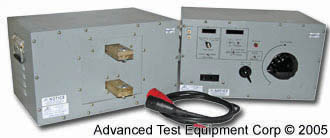
AVO/Multi-Amp/Megger CB-845 Circuit Breaker Test Set
The AVO / Megger / Multi-Amp CB-845 circuit breaker test set consists of a control unit that incorporates the latest in solid-state metering, control technology and a high-current output unit. The lightweight, two-section design of the CB-845 enables the user to easily transport the unit into areas previously inaccessible to high-current test equipment such as elevated or subsurface load centers, shipboard power panels, elevator machinery rooms and other isolated locations.
The AVO / Megger / Multi-Amp CB-845 Circuit Breaker Test Set is suitable for a wide variety of testing requirements including molded-case circuit breakers, thermal, magnetic or solid-state motor overload relays and other overcurrent protective devices. Additional applications include verifying the ratio of current transformers and testing ground-fault trip devices. The time-delay characteristics of motor overload relays and molded-case circuit breakers rated up to 500 amperes can be tested with the CB-845, when following the recommended test procedure of testing the time delay of thermal devices at three times their rating. Instantaneous trip elements can be tested with the higher currents required for these tests. For example, the test set will provide short-duration output of 5000 amperes through a typical 500 ampere, molded-case circuit breaker.| Input | Input Voltage (switch-selected): | 208 and 240 V, 1f, 30 A |
| Input Frequency (specify one): | 50 Hz OR 60 Hz | |
| Output | ||
| Output Range: | The output is continuously adjustable to accommodate a variety of test circuit impedances: 0 to 1200 A at 6 V max. | |
| Output Capacity | The output circuit is designed to provide short-duration overloads. The above output range will provide several times its current rating, provided the output voltage is sufficient to push the desired current through the impedance of the test circuit. The test set is capable of testing the time-delay characteristics of devices rated up to 500 A using a test current of three times their rating (1500 A). Additionally, to perform an instantaneous trip test, it will provide 5000 A through a typical 500 A, molded-case circuit breaker connected with the 4 ft (1.2 m) test-leads provided. | |
| Overload Capability | To increase use of the test set, it is designed so that the current ratings may be exceeded for short durations. Because the magnitude of the output current is determined by the impedance of the load circuit, the voltage rating must be sufficient to push the desired current through the device under test and the connecting test leads. | |
| Output Initiate Circuit |
The test set uses a solid-state output initiating circuit. To increase reliability and eliminate contact maintenance, this circuit uses a triac instead of a contactor to initiate the output. | |
| Output Initiate Control Circuit |
The initiating control circuit provides momentary and maintained modes to control output duration. The momentary mode is used whenever the output is to be on for a short duration. An example is an instantaneous trip test, or to avoid damage or overheating of the device under test while setting the test current. In the maintained mode, the output remains energized until manually turned off, or when performing timing tests, until the device under test operates which both stops the timer and de-energizes the output. | |
| Timer | A solid-state digital timer measures the elapsed time of the test in either seconds or cycles. It uses a crystal controlled oscillator and therefore, its accuracy is independent of the line frequency. | |
| Display | 5-digit, extra-bright LED display with 0.3 in. (7.62 mm) numerals | |
| Ranges (switch-selected) |
0 to 99.999 s | |
| 0 to 999.99 s | ||
| 0 to 99999 cycles | ||
| Accuracy | ±0.005% of reading, ±1 digit | |
- Digital memory ammeter: High-accuracy, direct reading instrument features read-and-hold memory for measurement
- Digital, multi-range timer: Crystal controlled, high accuracy instrument measures operating time to 1 ms.
- Lightweight and portable: Two-section unit has a total weight of only 175 lb (80 kg).
- High output current: Provides instantaneous current up to 5000 amperes through a 500 ampere circuit breaker.
- Solid-state output initiate circuitry: Solid-state output circuit switching eliminates need for contact maintenance.
- Protection: Overload and short- circuit protection is incorporated.
- Enclosure: The test set is housed in two stackable, interlocking, rugged, metal enclosures with convenient carrying handles. The control unit comes with a lid for protection of the controls during transportation. The unit is easily transported by and/or on a standard handtruck.
SKU: MULT-CB845